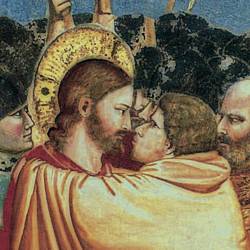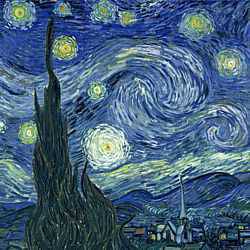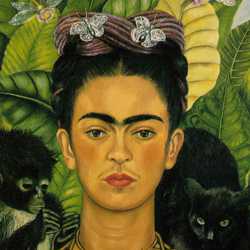Paintings by Frida Kahlo
Frida Kahlo, Mexico's greatest female artist, painted brutally honest self portraits that reveal her physical and psychological response to personal adversity.

FRIDA KAHLO (1907-1954)
'Self Portrait', 1940
(oil on board)
Frida Kahlo, Mexico's greatest female artist, painted brutally honest self portraits that reveal her psychological response to personal adversity. From her 143 paintings, 55 are self portraits that compile a degree of introspection not seen since the paintings of Van Gogh.
Frida Kahlo was born on July 6, 1907, in Coyoacan, a suburb of Mexico City. When she was six years old she contracted polio which left her with a deformed right foot and the cruel nickname, “Peg-leg Frida”. Her original ambition was to be a doctor but a streetcar accident in 1925 left her disabled and changed the path of her life. It was after this accident that she began to paint in order to relieve the boredom during her convalescence.
Frida and Diego: A Turbulent Relationship
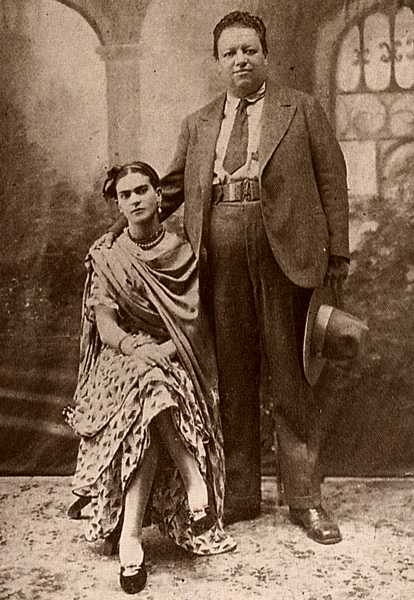
FRIDA KAHLO and DIEGO RIVERA
'Wedding Photograph', 1929
Frida Kahlo underwent more than thirty operations in the course of her life, and most of her paintings relate to her consequent suffering. They also chronicle her turbulent relationship with Diego Rivera, Mexico’s most famous painter, whom she met in 1928 and married in 1929. Rivera was frequently unfaithful to her, even starting an affair with her sister, Cristina. She retaliated with her own affairs. Eventually they divorced in 1939 but remarried a year later, only to resume hostilities where they left off. She is quoted as saying about the relationship,"There have been two great accidents in my life. One was the trolley, and the other was Diego. Diego was by far the worst."
Self Portrait in a Velvet Dress
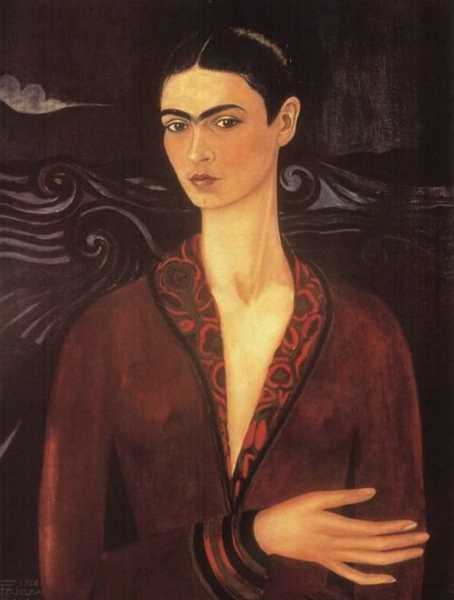
FRIDA KAHLO (1907-1954)
'Self Portrait in a Velvet Dress', 1926
(oil on canvas)
One of Frida's early works, the 'Self-Portrait in a Velvet Dress' suggests an influence and knowledge of European art. The elongation of the hands and neck recalls the Mannerist portraits of Bronzino, while the turbulent waves in the background evoke the deep emotional turmoil that can be found in the ice blue self portrait by Van Gogh in the Musée d'Orsay.
Frida began to deny obvious European influences such as Surrealism, as she, along with Diego, became the driving force of the ‘Mexicanidad’ movement which sought to increase the status of Mexican culture and decrease the Spanish influence from Europe. She started to wear traditional Mexican costumes and braided her hair with ribbons, flowers and jewellery to identify with indigenous Mexican culture. The imagery and colors in her paintings were also changed to reflect this national pride.
Although initially a self-taught painter from a humble background, she was, through her relationship with Diego Rivera, moving in the most fashionable and influential social circles. However, between 1930 and 1934, Frida and Diego moved to the USA to escape political persecution due to their Communist sympathies. During that time she fell pregnant twice and lost the child on both occasions, ultimately due to complications resulting from her streetcar injuries. The subjects of her paintings from this point onwards deal increasingly with her feelings about loss, infertility, pain and alienation.
Self Portrait with Thorn Necklace and Hummingbird

FRIDA KAHLO (1907-1954)
'Self Portrait with Thorn Necklace and Hummingbird'
1940
(oil on canvas)
The fusion of Christian and Aztec imagery is common in Mexican culture. In her 'Self-Portrait with Thorn Necklace and Hummingbird', Frida portrays herself as a Christ like victim where the crown of thorns is replaced by a necklace of thorns with a hummingbird 'medallion'. 'Huitzilopochtli', the Aztec god of war, is often depicted as a hummingbird. The painting is awash with symbolic imagery that reflects her inner conflicts. The monkey, a symbol of wickedness and a gift from Diego, pulls on the necklace causing her to bleed, a metaphor for their volatile relationship. The black panther, a symbol of bad luck and death, walks through the lush jungle, a symbol of fertility and life. Only the butterflies and dragonflies, both insects that metamorphose to a new cycle of life, offer any sign of hope.
The Suicide of Dorothy Hale

FRIDA KAHLO (1907-1954)
'The Suicide of Dorothy Hale', 1939
(oil on board)
The Suicide of Dorothy Hale' was commissioned by Clare Booth Luce, the publisher of the fashion magazine ‘Vanity Fair’ and a friend of both Dorothy Hale and Frida Kahlo, as a memento for the deceased woman’s mother. Dorothy’s husband, the artist Gardiner Hale, was killed in a car crash and left her without support. Overwhelmed by financial problems, Dorothy took her own life by jumping from her apartment building.
Frida paints the suicide with three consecutive stages of the fall in one image: first, a small figure of Dorothy leaps from a window high in the building; then a larger figure is portrayed plummeting through the clouds towards the ground; and finally the largest figure, the bloodied and broken body of Dorothy, lies prostrate on the sidewalk.
At the bottom of the picture, a trompe l’oeil inscription is written in ‘blood’, "In the city of New York on the 21st day of the month of October, 1938, at six o'clock in the morning, Mrs. Dorothy Hale committed suicide by throwing herself out of a very high window of the Hampshire House building. This 'retablo,' (a painted wooden relief) was executed by Frida Kahlo." To add to the horror of the image, the frame is painted to look like it has been splattered with bloodstains as a result of the fall.
On receipt of the painting Clare Booth Luce commented in her diary, ‘I could not have requested such a gory picture of my worst enemy, much less of my unfortunate friend’. Although she wanted to destroy the picture, she was persuaded to keep it.
Only someone like Frida Kahlo, who had personally endured and understood the effects of physical and psychological suffering could empathise with and respectfully address this distressing subject without appearing insensitive or sensational.
Sin Esperanza (Without Hope)

FRIDA KAHLO (1907-1954)
'Sin Esperanza (Without Hope)', 1945 (oil on canvas on board)
Sin Esperanza (Without Hope), 1945, is a study of despair at her own physical and psychological condition. Frida wrote on the back of the painting, "Not the least hope remains to me….. Everything moves in time with what the belly dictates….". This quote refers to the prescribed force feeding she endured as part of her convalescence.
The painting portrays her horrendous experience as a nightmare vision of suffering. Frida is trapped, helpless and crying, beneath the blankets of a hospital bed, whose bedspread is patterned with petri dishes incubating cultures of virulent bacteria. The bed is straddled by a grab rail which supports a huge funnel that is used to force feed her. A sickening glut of fetid animal flesh and bone is ground through the funnel into her mouth. This forcemeat is ironically topped off with a sugar skull [1] that bears her name - a spoonful of sugar that helps the medicine go down and doubles up as a harbinger of her doom. Her incapacity and isolation are amplified by the barren landscape and the presence of both the sun and moon in the sky indicates that she suffers perpetually, both day and night, without rest.
Self Portrait with the Portrait of Doctor Farill
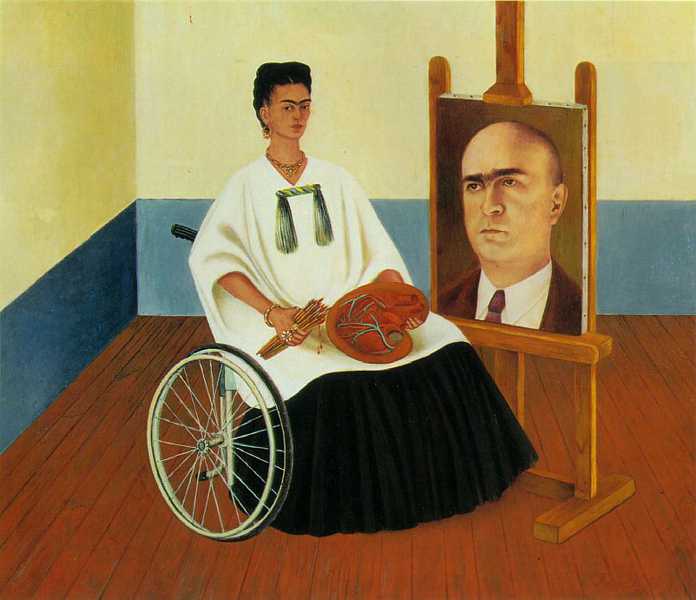
FRIDA KAHLO (1907-1954)
'Self Portrait with the Portrait of Doctor Farill', 1951
(oil on board)
In the 1950’s, Frida’s health seriously declined and the technical quality of her work suffered. Several spinal operations left her crippled with pain and she was confined to a wheelchair. 'Self-Portrait with the Portrait of Dr. Farill' (1951) is typical of this final period of her work. This double portrait, where she sits in her wheelchair holding her brushes and palette adjacent to her painting of her surgeon Dr. Farill, is a statement about the nature of her art. "My painting carries with it the message of pain ... Painting completed my life." A section of her heart replaces the palette on her lap, while her paintbrushes drip with blood, leaving the viewer in no doubt about their importance to her existence.
In the summer of 1954, Frida Kahlo died from pneumonia in the house where she was born. During her lifetime, she did not enjoy the same level of recognition as her husband, Diego Rivera, but today, her explicit, intensely autobiographical work is as critically acclaimed as that of her male peers.
Frida Kahlo Notes

FRIDA KAHLO (1907-1954)
'Frida in Coyoacán', 1939
(photo: Nickolas Muray)
Frida Kahlo was born on July 6, 1907, in Coyoacán, a suburb of Mexico City.
-
At six years old Frida contracted polio which left her with a deformed right foot and the cruel nickname, 'Peg-Leg' Frida.
-
A streetcar accident in 1925 left Frida Kahlo disabled and changed her life. She started to paint during her recovery.
-
Kahlo met the great Mexican artist Diego Rivera in 1928 and married him in 1929. Their relationship was always turbulent.
-
Kahlo began to deny any European influences in her art. She started to wear traditional Mexican costumes and braided her hair with ribbons and flowers to identify with her indigenous Mexican culture.
-
After two unsuccessful pregnancies, Kahlo's paintings increasingly dealt with her feelings about loss, infertility, pain and alienation.
-
Most of her works are self portraits that explicitly deal with her own physical and psychological suffering.
-
During her lifetime, she did not enjoy the same level of recognition as her husband, Diego Rivera, but today her intensely autobiographical work is as critically acclaimed as that of her male peers.
-
In the summer of 1954, Frida Kahlo died from pneumonia in the house where she was born.

